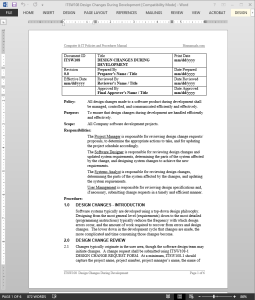Introducing the Software Design Change Procedure Template Word
Are you tired of dealing with the chaos that comes with software design changes? Look no further than the Software Design Change Procedure Template Word from Bizmanualz.
This comprehensive template provides a step-by-step guide for managing software design changes, ensuring that your team stays organized and on track. With clear instructions and customizable fields, this template can be tailored to fit the unique needs of your organization.
The Software Design Change Procedure Template Word includes sections for identifying the need for a design change, assessing the impact of the change, and implementing the change itself. It also includes a section for documenting the change and ensuring that all stakeholders are informed.
By using this template, you can streamline your software design change process and reduce the risk of errors or miscommunications. Plus, with the ability to customize the template to fit your specific needs, you can ensure that your team is following a process that works for your organization.
Don’t let software design changes cause chaos in your organization. Invest in the Software Design Change Procedure Template Word from Bizmanualz and take control of your software design change process today.
Software Design Change Procedure
The purpose of the Software Design Change Procedure is to ensure that any design changes occurring during software development are managed, controlled and communicated efficiently and effectively.
Software source code is developed in accordance with design inputs, requirements, and specifications defined by the systems analyst. Appropriate version control processes are followed to ensure proper source code change control and to maintain the integrity of the developed software code.
The Software Design Change Procedure applies to all company’software development projects. (6 pages, 923 words).
Software Design Change Responsibilities:
The Project Manager is responsible for reviewing design change requests/proposals, to determine the appropriate actions to take, and for updating the project schedule accordingly.
The Software Designer is responsible for reviewing design changes and updated system requirements, determining the parts of the system affected by the change, and designing system changes to achieve the new software requirements.
The Systems Analyst is responsible for reviewing design changes, determining the parts of the system affected by the changes, and updating the system requirements.
User Management is responsible for reviewing design specifications and, if necessary, submitting change requests in a timely and efficient manner.
Software Design Change Procedure Activities
- Software Design Changes
- Software Design Change Review
- Software Design Change Implementation
Software Design Change Procedure References
- ISO/IEC 12207:1995-Information Technology-Software Life-Cycle Processes
- IEEE/EIA 12207.0-Standard Industry Implementation of International Standard ISO/EIC 12207.0:1995
Software Design Change Procedure Forms






















Reviews
There are no reviews yet.